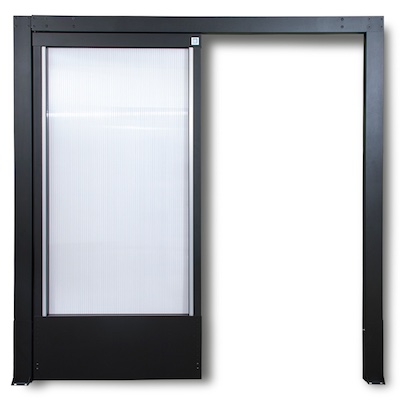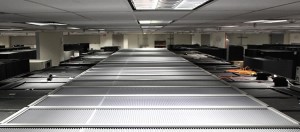We have an outstanding opportunity! Lead Polargy’s sales efforts into the new construction segment. That means getting to owners, architects, engineers, and general contractors with Polargy’s message and getting us selected for the new builds.
Category Archives: Data Center Best Practice
By the aisle or by the mile
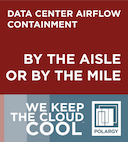 Polargy’s differentiation among containment manufacturers and contractors arises from our breadth of experience and depth of client understanding.
Polargy’s differentiation among containment manufacturers and contractors arises from our breadth of experience and depth of client understanding.
We bring to every project, whether large or small, not just attention to detail, precision design and product innovation, but years of diverse project experiences that allow us to visualize smart solutions and execute a project plan cleanly.
Big standardized new builds don’t have some of the “wild card” variables that small customized implementations often do, and while it’s gratifying to publicize large scale new construction containment deployments for Fortune 100 clients, we also enjoy sharing stories of modest retrofit projects brought online seamlessly. Every project, no matter how small, involves learning the client’s pain so we can solve it.
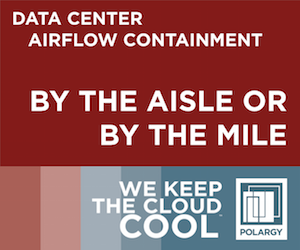
Whether you need just an aisle or literally a mile of airflow containment, Polargy is the call you make, because here’s what our clients say:
“The project went very well and we consider it a complete success, I wouldn’t change a thing. The outcome was exactly what we expected.”
Suffolk Public Schools in Virginia called Polargy when the air conditioning units in their ‘server room’ were over-tasked. The ‘server room’ at Suffolk was never designed for this use, it’s actually a converted storage room with 20 tons of A/C. Common but not ideal.
Director of Technology John Littlefield used rack heat extractors (photos below) but Trane HVAC engineers recommended containing the hot air and recooling it.
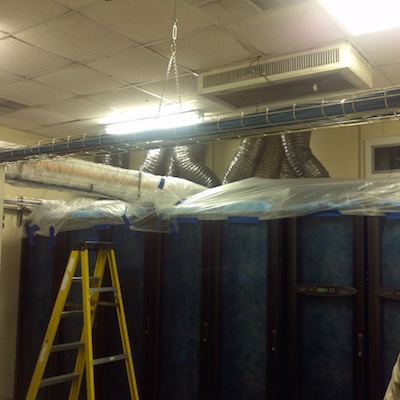
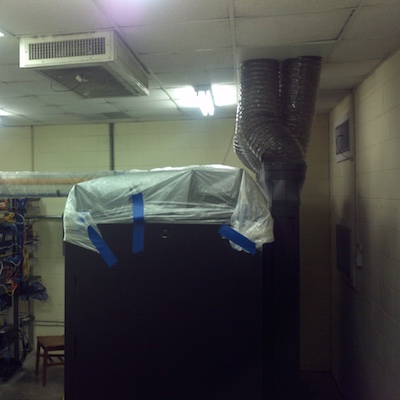 The goal of the containment project was typical: eliminate the rack heat extractors and improve the energy efficiency of the server room cooling. Littleton contacted Polargy and accomplished his goal quickly with a modest budget.
The goal of the containment project was typical: eliminate the rack heat extractors and improve the energy efficiency of the server room cooling. Littleton contacted Polargy and accomplished his goal quickly with a modest budget.
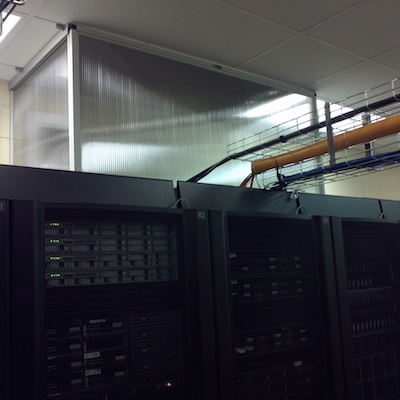
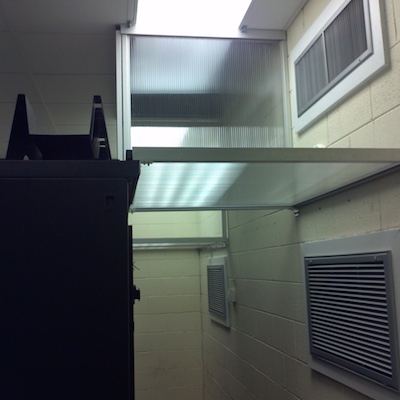 Since Polargy completed this project, the server room temperature is more stable, the cooling system runs more efficiently with less impact on the rest of the building, and the next step is to add an aisle-end door. The Polargy single-sliding door will look great.
Since Polargy completed this project, the server room temperature is more stable, the cooling system runs more efficiently with less impact on the rest of the building, and the next step is to add an aisle-end door. The Polargy single-sliding door will look great.
Decoding New Fire Codes
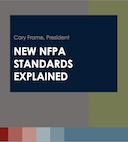 There is some confusion in the marketplace regarding changing fire safety regulations and materials deployed in the data center as airflow containment. To help clear things up, I prepared a technical briefling titled “New NFPA Standards Explained” which I have been presenting at AFCOM regional meetings. For the benefit of the many people who may be suffering a bout of this confusion and missed my presentations, I’ve provided my slides.
There is some confusion in the marketplace regarding changing fire safety regulations and materials deployed in the data center as airflow containment. To help clear things up, I prepared a technical briefling titled “New NFPA Standards Explained” which I have been presenting at AFCOM regional meetings. For the benefit of the many people who may be suffering a bout of this confusion and missed my presentations, I’ve provided my slides.
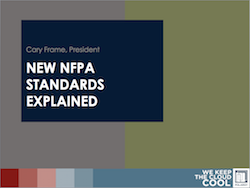 If you’re planning a containment project, whether retrofit or new construction, and want to be sure you’re interpreting fire codes correctly, give us a call. Polargy is the trusted partner in data center containment to get your job done right the first time, on time and on budget.
If you’re planning a containment project, whether retrofit or new construction, and want to be sure you’re interpreting fire codes correctly, give us a call. Polargy is the trusted partner in data center containment to get your job done right the first time, on time and on budget.
2014: Gratitude and a look ahead

 December invites reflection on (and gratitude for) the past year’s fortunes, as well as plans for the coming year. 2014 was a great year for Polargy in part because we saw a number of our industry forecasts come to pass:
December invites reflection on (and gratitude for) the past year’s fortunes, as well as plans for the coming year. 2014 was a great year for Polargy in part because we saw a number of our industry forecasts come to pass:
- Containment is increasingly viewed by owners as necessary, and a best practice, so sales cycles are accelerating as adoption grows
- Streamlined containment design and deployment in wholesale and co-location environments allows owners to respond to opportunities quickly and competitively
- Modular, floor-mounted and quick-build integrated containment solutions are growing in popularity, particularly in new builds with phased occupancy
- Growing demand for smart and reliable solutions like cold aisle pressure management and automation in legacy environments
During 2014, with a focus on proven customer needs and with eye toward the trends above, Polargy released:
- Freely downloadable digital PDF, CAD, BIM and Sketchup design files to simplify workflows for our Architect and Engineer customers and partners
- Freely downloadable pro forma product specifications for our complete PolarPlex line of containment solutions
- A colocation and wholesale customer support program (CSP) that makes quoting and deploying industry-leading PolarPlex containment faster and simpler than ever
- Thought leadership articles on important topics like thermal safety, future-proofing the data center and driving clarity around domain expertise and ownership.
Next year we look forward to introducing even more innovative containment solutions and sharing more thought leadership to help the data center containment market mature.
Until then, we’ll leave you with our sincere Thanks and Best Wishes for the remainder of 2014—and 2015.
Industry Perspective: N+1 Cooling On Paper Only
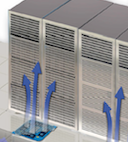 N+1 redundancy is a system design best practice because equipment failure happens; we expect it and we plan around it. In the case of data center cooling, we expect a CRAC to go down at some point, and with an N+1 system design we have a spare CRAC to fall back on. A major problem with this aggregate view of cooling is risk of starving a cold aisle when changing the CRAC lineup or as a result of CRAC failure, and this risk is amplified with cold aisle containment. Fortunately, we can easily and cost-effectively manage this risk with ‘air-mover’ fan tiles in the cold aisles.
N+1 redundancy is a system design best practice because equipment failure happens; we expect it and we plan around it. In the case of data center cooling, we expect a CRAC to go down at some point, and with an N+1 system design we have a spare CRAC to fall back on. A major problem with this aggregate view of cooling is risk of starving a cold aisle when changing the CRAC lineup or as a result of CRAC failure, and this risk is amplified with cold aisle containment. Fortunately, we can easily and cost-effectively manage this risk with ‘air-mover’ fan tiles in the cold aisles.
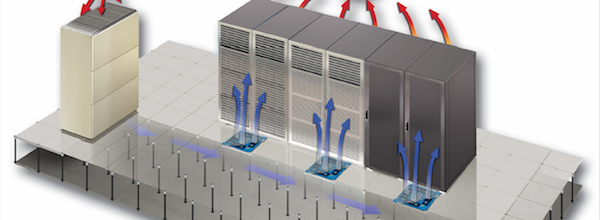 Time and time again we hear operators talk about how changing the CRAC lineup causes cooling airflow problems. Most of these comments come from legacy sites, though we’ve also heard them from new data centers. Interestingly, many operators fail to connect the dots between this airflow problem and N+1 redundancy. Many operators have a particular CRAC unit they don’t dare turn off and yet they assume their spare CRAC unit gives them N+1 redundancy. In our experience, about a quarter of small-to-medium data centers suffer from this false assumption; their N+1 redundancy is on paper only.
Time and time again we hear operators talk about how changing the CRAC lineup causes cooling airflow problems. Most of these comments come from legacy sites, though we’ve also heard them from new data centers. Interestingly, many operators fail to connect the dots between this airflow problem and N+1 redundancy. Many operators have a particular CRAC unit they don’t dare turn off and yet they assume their spare CRAC unit gives them N+1 redundancy. In our experience, about a quarter of small-to-medium data centers suffer from this false assumption; their N+1 redundancy is on paper only.
The Balancing Act
I can’t tell you how often I’ve heard comments like, “We need to keep CRAC Unit #3 on all the time or the room overheats” or “When we take CRAC #6 down for maintenance we get hotspots on the north side.” These problems are indicative of typical airflow behavior in raised floor environments:
- CFM into an aisle is highly dependent on under floor pressure and obstructions.
- CFM into an aisle is largely driven by the closest CRAC (the ‘CRAC of Influence’).
- Changing the CRAC lineup creates large swings in CFM delivered to an aisle.
- Total air supply may be sufficient but local supply may not (the ‘Distribution Problem’).
With these understandings, one can easily see how a change in the CRAC lineup can cause under floor pressure to change enough to introduce significant risk of an adverse thermal event.
When we think of cooling sufficiency, thermal safety and preventing problems, it’s in terms of normal operating conditions and failure conditions, and both scenarios are highly dynamic. In normal operating conditions we deal with routine changes in cooling demand and supply throughout room while the CRAC lineup remains unchanged. In failure conditions, we deal with a large change in under floor pressure when one CRAC goes offline and a spare unit takes over.
In normal operating conditions, routine changes in airflow demand and supply create risk of falling out of balance and starving a cold aisle. Cooling demand varies at the rack level, aisle level and room level, and can fluctuate either quickly or slowly. For example, a researcher who kicks off a large computational job can quickly heat up one or more racks of number-crunching servers. Or an IT guy swaps a 10kW rack in where a 2kW rack had been, but forgets to mention it to the facilities crew. These changes in demand for cooling create a less obvious change in cooling supply. When cooling demand in one aisle increases, the change in air consumption will affect the supply available to adjacent aisles. Such demand and supply changes during normal operations affect under floor pressure and can result in an aisle with localized low pressure.
In failure conditions, loss of a CRAC unit and replacement with the N+1 redundant unit will cause a change in under floor pressure. Because cooling supply to an aisle is most influenced by the nearest CRAC, and depending on the specifics of the under floor situation, a change in CRACs can result in a low-pressure zone and under-supplied aisles. There may be sufficient cooling supply, but because of the Distribution Problem, there is localized low pressure and even aisle starvation. In this case, even if the N+1 redundant CRAC unit comes online as planned, the best we can say is that the site has only partial redundancy.
Fixing With Fans
Fortunately, achieving true N+1 redundancy and mitigating cooling failure risk we’ve described can easily be achieved with active fan tiles that locally modulate airflow. Raised floor fan tiles, such as the Frost-Byte™ Raised Floor Fan Tile, vary speed to deliver cold air to the aisle based on sensed temperature or pressure differential versus a target setpoint. With several of these “air-mover“ tiles in a contained cold aisle, the right amount of cold air is supplied to mitigate thermal risk from inevitable cooling demand and supply changes during both normal operations and failure conditions.
These active fan tiles are built with a matrix of high performance variable speed DC fans in an aluminum enclosure attached to a standard 60% raised floor tile. Commonly, a temperature sensor mounted on the face of server racks controls the fans. Alternatively, sensors that measure pressure differential between inside and outside the contained cold aisle control the fans. This fan tile architecture auto-balances the cold aisles, eliminating starvation risk and improving thermal safety.
Other Fan Tile Benefits
An alternative solution to balancing cooling demand and supply is simply to over-supply an aisle, but with today’s emphasis on energy efficiency, the days of oversupplying are largely over. In fact, energy efficiency is the major factor driving the adoption of aisle containment, though even with containment, we sometimes still see oversupply due to balancing challenges. With active fan tiles, these remaining oversupply scenarios can be reduced or eliminated, yielding the full efficiency promise of cold aisle containment.
Additionally, by auto-balancing with active fan tiles, operators achieve labor savings from the elimination of routine manual balancing. The days of walking the room and swapping out perforated tiles are over. Active fan tiles eliminate the need to analyze aisles with a balancing hood (aka: flow balometer) to ensure the CFM in the cold aisle more than matches the IT load in that aisle. Likewise, because conditions in the room and aisles are so dynamic, Computation Fluid Dynamics (CFD) analysis for balancing purposes becomes obsolete since CFD provides a historical ‘snapshot’ of airflow that may no longer be relevant.
Lastly, if active fan tiles are powered through a UPS, they can ensure greater uptime if cooling is completely lost. In a catastrophic cooling failure condition, the under floor plenum holds a cool air reservoir, though without air pressure or air flow. Fan tiles running on UPS backup can continue to deliver and circulate cold air from within this chilled plenum. Testing demonstrates that supply air temperature through the fan tiles remained steady for more than 10 minutes even with all CRACs off.
The benefits of auto-balancing and solving the Distribution Problem that active fan tiles provide allow operators to enjoy true N+1 redundancy. Fan tiles offer significant additional benefits in a data center with cold aisle containment: even greater energy savings, local balancing and thermal safety.
Frost-Byte raised floor fan tiles combined with Polargy’s cold aisle containment take data center energy efficiency and thermal safety to the next level.
Phasing is all the rage
And it’s Just in Time.
Last week the Northern California 7×24 Exchange held their Spring event covering the topic of Construction Best Practices. One clear theme that emerged was the need for Flexible, Phased Capacity as new data centers are built out. Several speakers and panelists addressed market trends in outsourcing that drive this need.
Ron Vokoun from JE Dunn Construction, explained several trends in outsourcing and new construction that are driving the need for flexible capacity.
- Small businesses are moving IT to co-lo and cloud providers.
- Medium businesses are moving IT to co-lo and wholesale providers.
- Most new construction is purpose built, Greenfield, and larger in scale, yet with larger shells, initial fit-outs are modest and subsequent fit-outs are delayed until occupancy is closer.
Sam Brown, VP of Engineering and Construction for Server Farm Realty echoed this phasing approach explaining that customers tell them, “We need 500Kw now and over five years we plan to ramp into 2MW.”
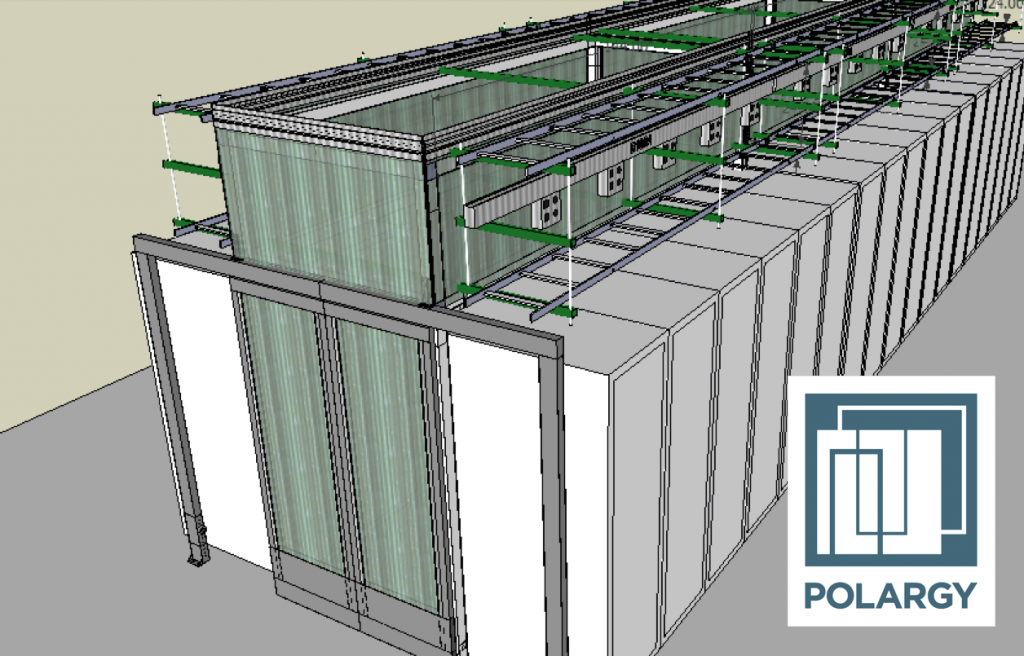 Polargy sees this emerging trend of “phasing” reflected in an increasing appetite for our Floor Mounted Infrastructure (FMI) among co-lo and wholesale providers.
Polargy sees this emerging trend of “phasing” reflected in an increasing appetite for our Floor Mounted Infrastructure (FMI) among co-lo and wholesale providers.
Our FMI solution incorporates containment, cable and power trays, and lighting. It is essentially a “modular white space” solution deployed in response to actual demand for capacity. Using a phasing approach, after the shell and raised floor is built out, the remaining infrastructure of containment, power, cable, and lighting can be deployed as needed. This is less constraining to the layout, which may not be fully understood until actual customers come in and their requirements clarify.
Perhaps most importantly for the industry, this “just in time” approach to data center infrastructure goes a long way toward smoothing bumps in the business model many insiders are anxious about, as I discussed in my previous post about maturation and rationalization. The ability to easily defer and fine-tune capital investment until actual demands are understood will be a competitive advantage for early adopters of phasing.
Because Polargy has deep expertise and experience with precision design and rapid deployment, we anticipate strong demand for our FMI solution that enables easy Phasing, as this new fit-out trend grows into an industry Best Practice.
Sealing gaps: We’ve come a long way
 Necessity is the mother of invention, as they say. In ancient times, boat builders would pack fibers, reeds and pitch into cracks between the planks of their boats to seal water leaks. I invented PolarDam five years ago because data center operators needed a low-cost, simple, flexible and safe method for sealing a wide variety of air gaps to improve cooling efficiency.
Necessity is the mother of invention, as they say. In ancient times, boat builders would pack fibers, reeds and pitch into cracks between the planks of their boats to seal water leaks. I invented PolarDam five years ago because data center operators needed a low-cost, simple, flexible and safe method for sealing a wide variety of air gaps to improve cooling efficiency.- Software. Yes, software. The data center was once home to countless software packages (CDs, manuals, etc.) for enterprise desktop support. Since all those boxes were just sitting around—and about the right size (5″ x 7″)—facilities managers used them to block off cable openings in empty racks.
- Foam peanuts. Inventive? Yes. Fire safe? No. We don’t know the whole story of how they were held in place, but they were called out by the fire marshal as not fire safe, so they had to go. The site manager replaced them with fire safe PolarDam air dam foam.
- Cardboard. This is no surprise given its ubiquity except for the obvious fire danger. In haste to achieve energy savings, this operator overlooked the potential to actually accelerate a possible fire by packing kindling throughout his data center.
- Rags. This is an odd example because there’s no reason to suspect the data center operator already had quantities of rags on hand, so they must have intentionally purchased a large quantity of new clean rags to plug air gaps. Probably not as bad as cardboard or software but certainly not up to code. PolarDam to the rescue again.
- Packing foam. Think about that pink packing foam that protects new-in-box computers and servers. Now imagine you’re supposed to wedge pieces of this rigid foam into air gaps of different shapes and sizes. It sounds like a nightmare, maybe even punishment, but definitely awkward and inefficient. Clearly not “the right tool for the job.”
- Wood. Scraps of wood. If I didn’t hear this myself, I’m not sure I would believe it. Is there any good use for wood in the data center? How does one fashion a custom wood block “air dam” on site without multiple cuts and resulting saw dust? If I hadn’t invented PolarDam, I think I’d sooner recommend fiber, reeds and pitch.
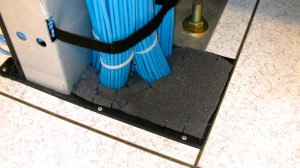 No need to seal air gaps with rubbish or other flammable materials, PolarDam seals your large and small air gaps, no tools required, and it’s fire safe.
No need to seal air gaps with rubbish or other flammable materials, PolarDam seals your large and small air gaps, no tools required, and it’s fire safe.Industry Perspective: Who Owns Containment?
Who owns containment? No one. This is the problem.

Written by Cary Frame, President and founder of Polargy, a provider of hot- and cold-aisle containment solutions.
Hot- and cold-aisle containment is a data center best practice experiencing hyper-growth in adoption because of its large impact on energy efficiency and operating cost savings. Interestingly, there is still no clear ownership of containment within the enterprise, among industry trades or between manufacturers.
Polargy works on the leading edge of growth in data center containment by focusing on product innovation and enabling fast and precise implementation. We offer this perspective on containment ownership based on our observations over more than five years in the containment market.
In our experience, what drives ambiguity around containment ownership is that it exists along the boundaries of job scope for multiple traditional players within data center whitespace. It also represents a more customized solution set than much of the industry is accustomed to.
On the user side, containment physically touches data center server racks, which are the responsibility of IT or IT Ops management within the enterprise, but it significantly impacts air conditioning performance, which is typically under the purview of facilities management. In addition, some enterprises have corporate energy managers who want or need to participate in the discussion. On the supply side, no single manufacturer type has claimed the category and no trade (mechanical, electrical, etc.) has taken a lead role. Because no one has stepped into full ownership of containment, up to five separate groups inside and outside the data center currently get involved.
Within the enterprise, Polargy has seen retrofit projects managed by data center operations as often as by facilities. However, we rarely see IT responsible for driving decisions, and though we find energy managers at the table, they almost never drive a project, but rather consult on ROI. When it comes to commissioning containment, all three constituents have strong stakes in the upgraded operating environment.
As part of Polargy’s standard engagement process we request that all three groups participate in outcome targets and commissioning planning. The key question these groups must agree on is what the new cold aisle temperature will be. Typically, IT people seek cold aisle temperatures in the mid-60s, data center operations people tend to favor temperatures in the low-70s, and facilities people prefer to run near the ASHRAE limit of 80.7°F. Besides these three operational groups, trades and manufacturers also suffer containment ownership ambiguity.
As a lead containment contactor, Polargy routinely trains and subcontracts a variety of firms from other trades to install containment. Polargy turnkey solutions have been installed by low voltage, flooring, interior, mechanical, and electrical contractors. Scholes Electrical and Mechanical in New Jersey has both electrical and low voltage groups, and Polargy has done projects with both groups for the same client. No particular contractor type has emerged as the one best suited to initiate and own containment projects.
“At CRB, we’ve seen a growing number of owners procure containment from containment companies like Polargy, but also from rack makers like Chatsworth,” reports Daniel Bodenski, Director of Mission Critical Services at CRB. “Likewise, in our mission critical project work, we’ve seen a variety of subcontractors install containment, including electricians, flooring contractors, and again the containment vendors themselves. No single group appears to be claiming full ownership yet.”
To the contrary, we’ve even seen contractors avoiding containment opportunities. In Chicago, the engineering design house Environmental Systems Design attempted to bid a containment project to four low voltage contractors, but none of them responded because they didn’t know what they were getting into. In Phoenix, a prominent mechanical contractor walked away from containment opportunities because they felt containment wasn’t “in their wheelhouse.”
The case of mechanical contractors is particularly curious because three things should give the mechanical trade an advantage in containment:
- They’re already responsible for air flow supply in the data center.
- They’re already doing routine maintenance on CRAC units, so they have regular access to customers they could sell containment to.
- They already have the mechanical skills necessary to install containment.
Yet, we haven’t even seen mechanical get traction with containment. Lack of clear ownership for containment means mechanical and other trades lose out on significant opportunities due to nothing more than lack of familiarity.
Among manufacturers, containment is dispersed among different types, from pure-play companies solely focused on containment to resellers and divisions within large diversified corporations. Containment is largely custom-designed to unique site conditions and varying rack sizes and layouts. This is why pure-play companies like Polargy with deep knowledge of requirements for both retrofit and new construction currently enjoy an advantage. As rack, low voltage and flooring manufacturers encroach on the containment market they are being forced to overcome the customization barrier.
Lack of clear and consistent ownership for containment among facilities management, trades, and manufacturers is clearly hamstringing containment-related decisions and implementations today. Containment is moving up the adoption curve, but the market will continue to see a variety of players at the table until market norms are established.
While these different constituent groups remain involved in containment to some degree, communication about business outcomes and implementation is paramount. Until there is better clarity vis-a-vis ownership of containment, decision authority will remain dispersed and responsibility will be shared, necessitating communication and coordination among more parties than necessary.
According to Rich Garrison, Senior Principal at Alfa Tech, “Because containment is intended to control airflow by separating hot and cold air, containment solutions are a fundamental part of the Mechanical solution. On the other hand, because it can be considered a wall or partition and often has an aesthetic component, the Architects claim ownership. To further complicate it, containment solutions are often positioned as accessories to rack solutions and can be considered part of the IT infrastructure. Ownership ambiguity extends to the trades as well. We see General Contractors, Mechanical, Electrical and Low Voltage sub-contractors all doing containment installation.”
In the current environment, while ownership remains ambiguous, Polargy sees MEP consulting engineers as the ideal containment owner from a design perspective due to their responsibility for air flow controls and monitoring. On the implementation side, pure-play containment manufacturers like Polargy, who double as containment contractors, will remain best suited to manage installation. Their advantage comes from superior product knowledge and deep and varied experience as the “go-to guy”during the formative period of the containment industry.
We anticipate this will remain the situation in this market for the next 2-4 years while data center containment ownership gets sorted out. Clear ownership of containment will facilitate even faster adoption of cutting edge containment solutions and lead to even greater data center efficiency.
Originally published on Data Center Knowledge.
Industry Perspective: Commissioning Containment Retrofits
Safely Transitioning the Data Center to a new Operating Environment
The Misunderstood Risk
Adding hot or cold aisle containment to an existing site offers the promise of energy savings, rescued capacity, and elimination of hot spots. Containment almost always offers strong return on investment with seemingly little downside risk. The problem is that “little downside” can be significantly misunderstood due to a common view of aisle containment as “put up some walls and turn off some CRACs.”
This misguided view of containment leads operators to plow ahead with airflow isolation projects, yet with no clear transition path to the new operating environment. These narrowly-defined containment projects result in money left on the table and huge risks associated with crippled post-install airflow.
To mitigate these risks and assure a successful outcome, aisle containment retrofits should be viewed more broadly as a Monitor, Contain, and Control project driven by a proper Commissioning Plan. This broader view of containment is based on three important factors:
- Data center airflow is dynamic, not static.
- Airflow must be managed continuously, not just once or even sporadically.
- Post-install, the cooling plant operates closer to its limits, which demands better monitoring.
Considering these factors, it’s easy to see that a containment project involves more than just putting up walls and turning off CRACs. It requires discussion and planning around monitoring, balancing airflow, controlling cooling and setting parameters and thresholds to which the site will be managed. All of these specifications and parameters are captured in a proper Containment Commissioning Plan.
Retrofit Trends
Increasing computing densities, increasing power costs, and demand for ever more capacity from existing infrastructure are key drivers of containment adoption. While these drivers apply to both new construction and containment retrofits, our focus here is on the latter.
The typical scenario in containment retrofits is cold aisle airflow management with roof panels and a raised floor site with perimeter cooling. Generally, and depending on the fire marshal, drop-away roof panels are more popular because they can be used under sprinklers with no special accommodations. This option is not available for vertical panels more often associated with hot aisle containment. Also in legacy sites, there are often overhead obstructions that make vertical panels untenable, which leaves the roof as the only practical option.
With this roof-based trend in retrofits, cold aisle containment essentially creates little rooms within the data center, each of which requires a balance of supply and demand airflow. These separate balanced airflows make the project more challenging than merely installing doors and panels. Furthermore, the constantly changing airflow supply and demand, combined with operating the cooling plant closer to minimum required capacity, forces a careful approach to the airflow equation. These factors make a suitable Containment Commissioning Plan critical to risk management and overall project success.
Herding Cats
A proper Retrofit Containment Commissioning Plan aligns stakeholders to cooling changes and project goals, and outlines various monitoring, balancing, and set-point adjustments steps. More simply, a proper Containment Commissioning Plan answers two key operating questions:
- What is our new cold aisle operating temperature?
- How will we know when we get there?
Persuading the Facilities, Operations and IT groups within the enterprise to agree on the new cold aisle temperature is typically the hardest part. Facilities advocates for ASHRAE’s upper limit recommendation of 80.6°F (27°C), Operations is more comfortable with cold aisle temperatures around the mid- to upper-70s and IT prefers even cooler targets, often in the low 70s.
The second question is simply answered by “monitoring,” though more often than not, legacy sites have little or no temperature monitoring at the rack level. Once stakeholders agree on an answer to the first question it becomes obvious there is a monitoring gap, so planning typically turns to closing that gap. At this point in the process, people working through this planning phase often experience an “ah-ha” moment, realizing that the project scope is broader than their narrow, initial view.
What’s in the Plan?
After answering the two key questions (above), the rest of the Commissioning Plan is fairly straightforward. Again, we assume the project is cold aisle containment with a roof. The Plan outline that follows may be modified for other containment topologies.
- Determine maximum cold aisle temperature threshold
- Establish a monitoring plan
- Conduct an initial airflow balancing
- Determine and set a schedule for turning off CRAC/CRAHs
- Determine and set a schedule for raising set points
- Rebalance and continue adjustments until limits are reached
Temperature threshold and monitoring
Temperature threshold is a standard that drives all subsequent commissioning activities, including monitoring, which assures thermal safety through the project. To highlight the importance of monitoring, understand that at the start of a project a site often does have cold aisles out of balance, with one feeding another. Without containment, this common overfed/starving situation goes unnoticed, but after installing containment, underfed aisles immediately starve.
Since most legacy sites lack rack-level monitoring, a decision must be taken to invest in a monitoring/DCIM system, such as an automated, wireless mesh network. Short of that, monitoring may be relegated to a form of a manual ‘Sneaker Net’ process with temperature strips and/or laser temperature guns. A manual approach can work and many projects use it. Now at this point, an operator could also consider under-floor or differential air pressure, but we find that most retrofit projects lack the appetite for this step.
Initial Balancing
The objective of initial balancing is to eliminate gross imbalances prior to the adjustment phase. The current cooling lineup is maintained as floor tiles are juggled to achieve a common inlet temperature. That initial temperature target is loosely set by sampling the room to determine the current average inlet temperature at the front of the rack. A stock of some solid 25% and 60% perforated floor tiles will be needed for this and subsequent phases. It is common for a site to have too many perforated tiles installed.
CRAC/CRAHs and Set Points
The target number of CRACs to be turned off is usually set during the analysis phase. The Plan should identify specific CRACs, as well as a sequence and schedule for turning them off. The schedule simply spaces out shutdowns so that the room has enough time to stabilize, which could require as little as a few hours to as much as a couple days. Importantly, monitoring and rebalancing occurs during the time between shutting down CRAC units.
New set point targets are a function of the CRAC controls. Most legacy sites are controlling by Return Air Temperature (RAT), and a typical scenario is RAT set to 75°F. Clearly, if the new cold aisle temperature target is 78°F then RAT must be elevated well into the 90’s. New high temperature alarm set points must be set as well. The process of raising the RAT mirrors the process of turning off CRAC units. A proper Containment Commissioning Plan includes a schedule for gradually raising set points, allowing adequate time for the environment to stabilize. The Commissioning Plan should include multiple cycles of adjustment, monitoring and rebalancing.
Adjustment Process/Dynamic Airflow
As new containment is installed, monitoring assures that aisle starvation does not result. After containment is installed, the shutting down of CRACs, the set point increases and the rebalancing steps are taken. The Commissioning Plan is followed until the new target cold aisle temperature threshold is reached and is stable. A likely outcome is that the threshold will be reached for some zones while other areas will remain cooler than the target. At this point, the containment commissioning project is complete, though monitoring should be sustained, on the expectation that airflow supply-demand balance will change over time, necessitating additional adjustments.
The Containment Commissioning Plan outlined here does not address automation of monitoring and control functions, which we have left as a manual process. Short of deploying a full-fledged automated monitor and control system, active fan tiles are an option for achieving partial automation without the cost and complexity of procuring and integrating a full-fledged system. Fan tiles can help with localized balancing, which is especially important in the cold aisle containment scenario typical of retrofits. Fan tiles perform a local monitor and control function by adjusting fan speed to increase or decrease airflow into the aisle as temperature rises or falls. The fan tile option should be considered during initial discussion and planning of monitoring.
Conclusion
A proper Commissioning Plan for new aisle containment assures a seamless transition to the new operating environment and a successful outcome from both the financial and operational risk management perspectives. Approaching a new aisle containment project with a holistic view that includes monitoring and controls will help align stakeholders and facilitate a Plan that adequately addresses thermal safety. Lastly, any new implementation of airflow containment creates a new cooling environment that requires ongoing monitoring and continuous adjustment. The implementation of a well-thought out Plan will rise to the challenges of refining such a changing environment.
Originally published on Thermal News.
The secret’s out about PolarDam
This month we followed our customers’ lead and ‘let the cat out of the bag‘ about all the ways to use PolarDam Air Dam Foam to seal off air gaps throughout the data center.
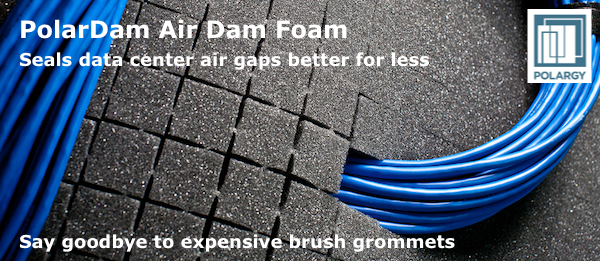 You probably remember the old story about 3M’s accidental invention of Post-It Notes.
You probably remember the old story about 3M’s accidental invention of Post-It Notes.
 The invention of PolarDam Air Dam Foam was a little like that:
The invention of PolarDam Air Dam Foam was a little like that:
- Accidental product insight
- Simple solution to a real problem
- Subsequent use case proliferation
If you spend as much time with customers as Polargy does, you become very familiar with the details and nuance of their challenges. This means we’re often positioned to solve—and even anticipate—customer problems with innovative containment solutions.
Almost more importantly (for business), staying close to a large number of varied customers allows Polargy to recognize common pain points across the market.
 In the PolarDam case, our customer needed to close about a hundred air gaps of varying sizes, and it was clear that brush grommets weren’t going to get the job done. The high cost of brush grommets alone made them a bad option but they also just didn’t work.
In the PolarDam case, our customer needed to close about a hundred air gaps of varying sizes, and it was clear that brush grommets weren’t going to get the job done. The high cost of brush grommets alone made them a bad option but they also just didn’t work.
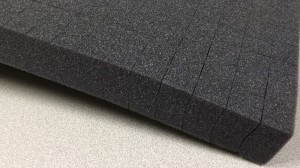 Together with the customer, we developed a simple, customizable air gap sealing solution that beats brush grommets every time in terms of fit, cost and flexibility. It was clear to us immediately that the same air gap challenges this customer had were common to data centers everywhere.
Together with the customer, we developed a simple, customizable air gap sealing solution that beats brush grommets every time in terms of fit, cost and flexibility. It was clear to us immediately that the same air gap challenges this customer had were common to data centers everywhere.
So that’s where it started, but now it’s taken on a life of its own. I even made a video about it.
“Everyone knows that air leakage reduces data center cooling efficiency. The best kept secret for sealing air gaps is PolarDam Air Dam Foam.”
And here’s a little gallery of some of the most popular PolarDam applications:

Normal cable cutouts where you could use a brush grommets (but prefer PolarDam’s far lower cost)
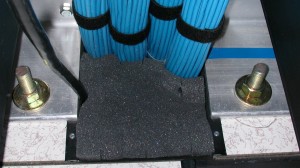
Odd-shaped or obstructed cutouts that no brush grommet will fit
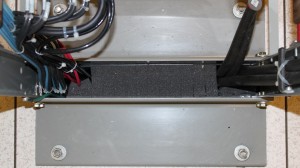
2-post racks, either on top or through the floor
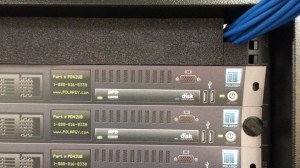 Blanking inside racks when you’re blanking off an entire 1U or 2U (or more) but especially when you’re running cables out through the front of the rack. Try to do that with a rigid blanking panel.
Blanking inside racks when you’re blanking off an entire 1U or 2U (or more) but especially when you’re running cables out through the front of the rack. Try to do that with a rigid blanking panel.
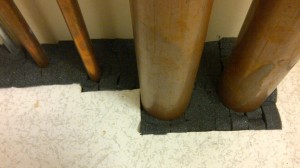 Pipe penetrations through a floor or near a wall…
Pipe penetrations through a floor or near a wall…
…and there are so many more.
The important thing to remember is that PolarDam closes all these air gaps in seconds. No tools, no measuring, no messy drilling. Just tear it to the perfect size and push it into place with your hands.
Just one part number: PD24

